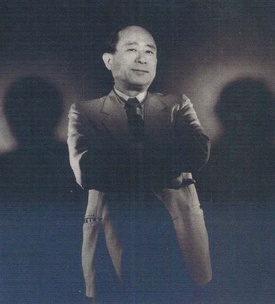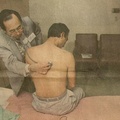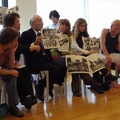Dr. Mitsuo Inouye, born on April 27, 1925 to Japanese American immigrant parents living in California, worked to achieve the American dream not only for himself and his family but also for a group of about a thousand that People Magazine would later call “lost Americans.” In an era that saw the passing of the California Alien Land Law of 1920, which was specifically aimed at the Japanese and made it illegal for Japanese Americans to own farmland, and the Johnson-Reed Act (which contained the Asian Exclusion Act), which greatly limited the number of immigrants from foreign, especially Asian, countries, being a Japanese American like Inouye came with substantial amounts of racism and poverty. As immigrants who barely spoke English, the Inouyes, were forced to work as humble farmhands struggling to make a living. Then in December 1941, with the bombing of Pearl Harbor by the Japanese, their already difficult lives took a turn for the worse.
Initial post-Pearl Harbor articles from the American media appeared to show support for the Japanese Americans as seen in articles written by the LA Times stating that, “thousands of Japanese here and in other coast cities [are] good Americans, born and educated as such,” and the Sacramento Bee, “The wise and sensible American will avoid [racism] as he would a deadly poison or fatal pestilence [and respect] the traditional and time-honored American policy—fairness to all who love the Flag, no matter where the accident of parentage may have located their birthplace.”1 Although these statements of support appear to be quite strong and sympathetic, the apparent “American policy” mentioned in the second article was by no means a policy at all and immigrants, especially Asian immigrants, were subject to considerable amounts of un-“fairness” solely based on the location of “their birthplace” (like in the aforementioned Johnson-Reed Act) or the birthplace of their ancestors. This support, just like the policy presented in the Sacramento Bee, was a transient mirage and soon the government, as well as the general American populace began calling for the internment of the Japanese Americans due to concerns regarding their threat to national security.
In early 1942, the Inouyes began contemplating a return to Japan, but were urged by Mitsuo and their other children to remain in the country they now considered to be their home. Soon after, they, along with thousands of other Japanese Americans, were stripped of their few possessions and relocated to internment camps. For two years Mitsuo lived with the rest of his family at the Heart Mountain internment camp but in 1944 at the age of 18 he along with his brother Ichiro (aged 23) enlisted in the U.S. army.
Ichiro was a private first-class member of the 100th Battalion where he earned a Combat Infantry Badge and much later the Congressional Gold Medal, while Mitsuo trained as a private with the American Military Intelligence Services where he never anticipated seeing combat. However, in the summer of 1945, Mitsuo began training along with the American Military Intelligence Services for an invasion of Japan. Then on August 6th the atomic bomb was dropped. The young Inouye and his fellow trainees, who had believed that their invasion of Japan would lead to their imminent deaths, reacted to the bomb by “erupt[ing] in cheers.”2 They did not think of the thousands of people the bomb had killed and severely wounded (including close relatives of Lily Ann Inouye, Mitsuo’s future wife) and they certainly didn’t know of the American citizens who were victims of the bomb; however, “They knew the bomb would make an invasion unnecessary,”3 and that the U.S.A. had won the war, which at the time was all that mattered to them.
The atomic bombs, dropped on the cities of Hiroshima and Nagasaki in Japan, were the most devastating usage of military force that the world has ever experienced. While the usage and necessity of the bombs, the Japanese victims, and many of the bomb’s effects have been thoroughly discussed (with little consensus of opinion), one small group of individuals who epitomize both the struggles of the Japanese Americans and atomic bomb survivors, the American atomic-bomb survivors, have lacked major media coverage or even general discussion.
Beginning in about 1947 with the end of WWII, about a thousand (three-fourths of whom were female) of these American atomic-bomb survivors immigrated back to the United States (mainly California and Hawaii). Beginning in the early 1970s, nearly three decades after the dropping of the atomic bomb, the American hibakusha (another word for atomic-bomb survivor) began to actively fight for free healthcare provided by the American government. Among the leaders in this fight for free healthcare was Mitsuo Inouye, who made it one of his life’s missions to fight for retribution for the atomic bomb survivors. For many of the American hibakusha it was not purely the economic aspect of the free healthcare that appealed to them, it was what it represented: their permanent spots in the melting pot of America.
In the end, the Japanese atomic-bomb survivors did not receive any form of free healthcare from the U.S. government; the ultimate reasons being the United States’ mixed understanding and opinion with regards to: the effects of radiation and the citizen, not enemy, status of the American hibakusha, not simply the economic connotations that would come with providing free or at least reduced cost health insurance.
The narrative of the American hibakusha contains difficult and often overshadowed struggles; their story includes not only the tragic accounts of lost family members and profound injuries, which haunt all atomic-bomb survivors, but also societal ostracism and rejection from the country that considered them the enemy, the same country they still considered their home.
As was traditional, many of the American hibakusha had gone to Japan in order to get a formal Japanese upbringing (and some were even there just to visit family), but after the bombing of Pearl Harbor they were unable to return to the U.S.A.; thus thousands of essentially unidentified American citizens became eternal victims of the atomic bomb. In Hiroshima, the American hibakusha faced the terrors of the atomic bomb, many died, lost family members, or suffered immense physical and mental injuries but this was by no means the end of their plight. Starting circa 1947, thousands of Japanese Americans, some of whom were hibakusha, returned to the United States in search of a new life far from the destroyed cities of Hiroshima and Nagasaki.4
Life in the U.S.A. for many of the hibakusha was not easy; to many the U.S.A. was still a pretty foreign country as most had spent their childhoods in Japan. In addition, being a Japanese American came with high degrees of racial discrimination from Americans who would call them, “dirty Japs,” to teachers and employers who would discriminate against them due to their racial background.5
At around the same time that hibakusha began to return to the U.S.A., the Inouyes returned to farming in order to put Mitsuo through college at the University of California, Berkeley and later Medical School at the University of California, San Francisco. After training as a resident, Dr. Inouye set up a successful medical practice and gave jobs as well as money to the rest of his family. They were living the American dream. It was in the 1960s through this practice that Dr. Inouye would come into contact with these “lost Americans,” the hibakusha, who wished to feel genuinely American. In part due to fear of persecution and in order to assimilate into American culture, the Japanese Americans who had been in Japan during the war refrained from discussing their WWII experiences; a fellow activist, Dr. Tom Noguchi, would later say, “These Americans of Japanese ancestry had lived in such a manner to give proof of their loyalty to America, and any remembrance of the war was best forgotten.”6
For hibakusha it was even more essential for them to conceal their secret as they feared societal discrimination and a potential increase in cost or loss of health insurance; it was only through doctor-patient confidentiality that patients would venture to confide in Dr. Inouye (and Dr. Noguchi) the knowledge they were in fact atomic-bomb survivors. As Dr. Inouye would later say, “When identified as bomb survivors, there were discriminating policies in employment, and in acquiring life and health insurance. Marriage prospects were dim. Victims became isolated within their community, who understood very little of their plight,”7 thus the hibakusha could not, on their own, openly confess their atomic bomb experiences. In addition to this fear of being outed as hibakusha, as Kaz Suyeishi, an American hibakusha proclaimed, being a hibakusha is “like living with a bomb,”8 a bomb without a known detonation whose deadly wounds would take years to kill or even harm its victim.
Notes:
1. John Davenport, The Internment of Japanese Americans During World War II: Detention of American Citizens. (New York: Chelsea House, 2010), 5.
2. People magazine article from Dr. Inouye’s collection, p. 2
3. Ibid.
4. Rinjiro Sodei, Were We the Enemy?: American Survivors of Hiroshima (Boulder, CO.: Westview Press, 1998), 35.
5. Quote from an interview in: David Yoo, Growing up Nisei: Race, Generation, and Culture among Japanese Americans of California, 1924-49 (Urbana: University of Illinois Press, 2000), 164.
6. Transcript of H.R. 8440 from Dr. Inouye’s collection, p. 25
7. Transcript of H.R. 8440 from Dr. Inouye’s collection, p. 54
8. Los Angeles Times article from Dr. Inouye’s collection, p. 1
© 2014 Jordan Helfand





